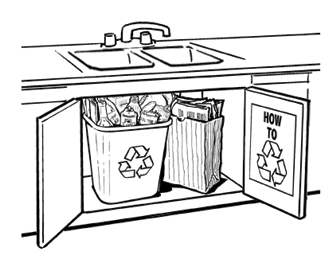In-unit receptacles and storage spaces are just as important as their external counterparts, because these receptacles encourage occupants to recycle. This applies to apartment kitchens and to commercial kitchenettes and conference rooms, where substantial amounts of organic discards may be generated. In some jurisdictions, receptacles are provided by the local government or the collection company. If possible, take into account any predetermined sizes and shapes of containers.
If space below a sink is designated for this purpose, provide additional cupboard space for items commonly stored below the sink, such as cleansers and cleaning utensils. Also consider convenient roll-out shelving for recycling tubs or bags.
In commercial settings, the typical receptacles range in size from 13 to 23 gallons, are exposed to view or within a cabinet, and have lids that prevent flying insects from gaining access.
Label the space designated for internal receptacles. The best approach is an 8-1/2 x 11-in. frame for an instruction sheet on the inside of the cupboard door or above the receptacle, but a simple “Recycling” or “Organics” label in embossed plastic will also encourage proper discard management.
In multi-family settings, residents often must provide their own in-unit receptacles. As a rule of thumb, provide three cubic feet in the kitchen for recyclables, three cubic feet for refuse, and one cubic foot for organics.
In commercial settings, the typical receptacles range in size from 13 to 23 gallons, are exposed to view or within a cabinet, and have lids that prevent flying insects from gaining access.
